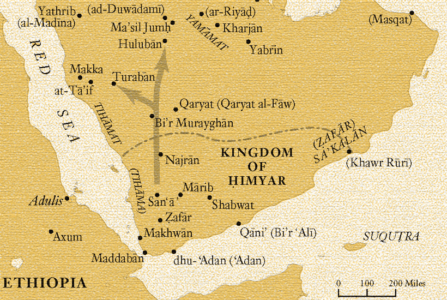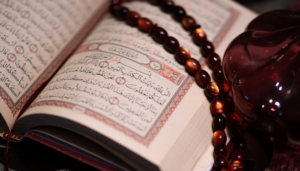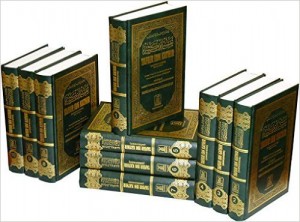Story of the People of the Ditch
When Quran talked about the People of the Ditch
I was Reading the tafseer of Surah Al Buruj ,When I came across the story of the People of the Ditch .Today Many Muslims are prosecuted.They are tortured to death and burned and buried alive in regions like Rohingya, Aleppo and Madaya etc. The Muslims in these area are so oppressed and neglected that reading about them fill our eyes with tears.What really struck me after reading the story of the People of the ditch is that the People who keep their Imaan alive in face of such trials of Allah are held in high esteem in the eyes of Allah and they have been addressed in Quran.
Story of people of the Ditch in Quran
The story of the People of the Ditch is mentioned in Surah Buruj the 85th chapter of Quran.
The People of the Ditch are also known as Ashab al ukhdud
Allah Taala mentions in the Noble Quran:
“Cursed were the People of the Ditch. Fire supplied [abundantly] with fuel, When they sat by it [the Fire]. And they witnessed what they were doing against the Believers [i.e. burning them]. They had nothing against them except that they believed in Allah, the Almighty, Worthy of all praise! The One to Whom belongs the dominion of the Heavens and the earth. And Allah is Witness over everything. Verily those who put to trial the believing men and the believing women [by torturing them and burning them] and then do not turn in Repentance [to Allah will have the torment of Hell and they will have the Punishment of the Burning Fire.” (85:4-10)

Lesson from the Story of the People of the ditch: أصحاب الأخدود
The story of the People of the Ditch is mentioned in Surah Buruj the 85th chapter of Quran. It warns the disbelievers of the evil consequences of the persecution and tyranny that they were perpetrating on the converts to Islam, and to console the believers, so as to say: “If you remain firm and steadfast against tyranny and coercion, you will be rewarded richly for it, and Allah will certainly avenge Himself on your persecutors on your behalf.”
In this connection, the story of the people of the ditch (ashab al-ukhdud) had been related, who had burnt the believers to death by casting them into pits full of fire. By means of this story the believers and the disbelievers have been taught a few lessons.
First, that just as the people of the ditch became worthy of Allah’s curse and punishment, so are the oppressors also becoming worthy of it.
Second, that just as the believers at that time had willingly accepted to sacrifice their lives by being burnt to death in the pits of fire instead of turning away from the faith, so also the believers now should endure every persecution but should never give up the faith.
Third, that Gods acknowledging Whom displeases the disbelievers and is urged on by the believers, is Dominant and Master of the Kingdom of the earth and heavens; He is self-praiseworthy and is watching what the two groups are striving for. Therefore, it is certain that the disbelievers will not only be punished in Hell for their disbelief but, more than that, they too will suffer punishment by fire as a fit recompense for their tyranny and cruelties.
Likewise, this also is certain that those, who believe and follow up their belief with good deeds, should go to Paradise and this indeed is the supreme success. Then the disbelievers have been warned, so as to say: “God’s grip is very severe. If you are proud of the strength of your hosts, you should know that the hosts of Pharaoh and Thamud were even stronger and more numerous. Therefore, you should learn a lesson from the fate they met. God’s power has so encompassed you that you cannot escape His encirclement, and the Qur’an that you are bent upon belying, is unchangeable: it is inscribed in the Preserved Tablet, which cannot be corrupted in any way.”
The Story of the People of the Ditch
The story of the People of the Ditch is very interesting. Many events are reported concerning this story. Let us read about them-
One of the events has been reported by Hadrat Suhaib Rumi from the Holy Prophet (upon whom be peace), saying that a king had a magician at his court who on becoming old requested the king to appoint a boy who should learn magic from him. Accordingly the king appointed a boy. But the boy while going to the magician’s place and coming hack home also started visiting on the way a monk (who was probably a follower of the Prophet Jesus) and being influenced by his teaching turned a believer. So much so that by his training he acquired miraculous powers. He would heal the blind and cure the lepers.
When the king came to know that the boy had behaved in the Unity of God, he first put the monk to the sword: then he wanted to kill the boy, but no instrument and no device had any effect on him. At last, the boy said to the king: “If you are bent upon killing me, shoot an arrow at me with the word: Bi-ismi Rahhil-ghulam (in the name of this boy’s Lord) in front of the assembled people. and I shall die.” The king did as he was told and the boy died. There upon the people cried out that they affirmed faith in the Lord of the boy.
The courtiers told the king that the same precisely had happened which Ire wanted to avoid: the people had forsaken his religion and adopted the boy’s religion. At this the king was filled with rage. Consequently, hr got pits dug out along the roads, got them tilled with tire and ordered all those who refused to renounce the new faith to he thrown into the tire. (Ahmad, Muslim. Nasa’i, TIrmidhi, Ibn Jarir. ‘Abdur Razzaq. Ibn Abi Shaibah, Tabarani. ‘Ahd hin Humaid)
The second event has been reported from Hadrat ‘Ali. He says that a king of lean drank wine and committed adultery with his sister resulting in illicit relations between the two. When the secret became known, the king got the announcement made that God had permitted marriage with the sister. When the people refused to believe in it, hr started coercing them into accepting by different kinds of punishment; so much so that he began to cast into the pits of fire every such person who refused to concede it. According to Hadrat ‘AIi, marriage with the prohibited relations among the fire worshipers has begun since then (Ibn Jarir).
The third event has been related by lbn ‘Abbas probably on the hasin of the Israelite traditions, saying that the people of Babylon had compelled the children of Israel to give up the religion of the Prophet Moses (peace he upon himl: so much so that they cast into pits of tire all those who refused to obey. Ibn Jarir, ‘Ahd bin Humaid).
The best known event, how ever, relates to Najran: People of the Ditch najran

The story of Najran has been related by Ibn Hisham, Tabari. Ibn Khaldun. the author of Mujam al-Buldan and other Islamic historians. Its resume is as follows: Tuban Asad Abu Karib, king of Himyar (Yaman), went to Yathrib once where he embraced Judaism under the influence of the Jews, and brought two of the Jewish scholars of Bani Quraizah with him to Yaman. There he propagated Judaism widely.
His son Dhu Nuwas succeeded him and he attacked Najran which was a stronghold of the Christians in southern Arabia so as to eliminate Christianity and make the people accept Judaism. Ibn Hisham says that these people were true followers of the Gospel of the Prophet Jesus)
In Najran he invited the people to accept Judaism but they refused to obey. There upon he caused a large number of the people to he burnt in the ditches of fire and slew many others with the sword until he had killed nearly twenty thousand of them. Daus Dhu Tha laban an inhabitant of Najran escaped and went. according to one tradition. to the Byzantine emperor, and according to another. to the Negus king of Abyssinia, and told him what had happened
According to the first tradition, the emperor wrote to the king of Abyssinia, and according to the second, the Negus requested the emperor to provide him with a naval force. In any case; an Abyssinian army consisting of seventy thousand soldiers under a general called Aryat, attacked Yaman, Dhu Nuwas was killed, the Jewish rule came to an end, and Yaman become a part of the Christian kingdom of Abyssinia.
The statements of the Islamic historians are not only confirmed by other historical means but they also give many more details. Yaman first came under the Christian Abyssinian domination in 340 A.D. and this domination continued till 378 A.D.
The Christian missionaries started entering Yaman in that period. About the same time, a man named Faymiyun (Phemion), who was a righteous, earnest, ascetic man and possessed miraculous powers, arrived in Yaman and by his preaching against idol-worship converted the people of Najran to Christianity.
These people were ruled by three chiefs: Sayyid, who was the principal chief like the tribal elders and responsible for external affairs, political agreements and command of the forces, ‘Aqib, who looked after the internal affairs and Usquf (Bishop), the religious guide. In southern Arabia Najran commanded great importance, being a major trade and industrial center with tussore, leather and the armament industries. The well-known Yarnanite wrapper and cloak (hulls Yamani) was also manufactured here.
On this very basis, Dhu Nuwas attacked this important place not only for religious but also for political and economic reasons. He put to death Harithah (called Arethas by the Syrian historians), Sayyid of Najrain, killed his two daughters in front of his wife Romah and compelled her to drink their blood and then put even her to death. He took out the bones of Bishop Paul from the’ grave and burns them, and ordered women, men, children, aged people, priests and monks, all to be thrown into the pits of fire.
The total number of the people thus killed has been estimated between twenty and forty thousand. This happened in October, 523 A.D. At last, in 525 A.D. the Abyssinians attacked Yaman and put an end to Dhu Nuwas and his Himyarite kingdom. This is confirmed by the Hisn Ghurab inscription which the modern archaeologists have unearthed in Yaman.
In several Christian writings of the 6th century A.D. details of the event relating to the people of the ditch” have been given, some of which are contemporary and reported from eye-witnesses. Authors of three of these books were contemporaries with the event. They were Procopeus, Cosmos Indicopleustis, who was translating Greek book of Ptolemy under command of the Negus Elesboan at that time and resided at Adolis, a city on the sea-coast of Abyssinia, and Johannes Malala froth whom several of the later historians have related this event.
After this, Johannes of Ephesus (d. 585 A.D) has related the story of the persecution of the Christians of Najran in his history of the Church from a letter of Bishop Mar Simeon who was a contemporary reporter of this event. Mar Simeon wrote this letter to Abbot von Gabula; in it Simeon has reported this event with reference to the statements of the Yarnanite eye-witnesses present on the occasion. This letter was published in 1881 A.D from Rome and in 1890 A.D. in the memoirs of the martyrs of Christianity Jacobian Patriarch Dionysius and Zacharia of Mitylene have in their Syriac histories also related this event. Ya`qub Saruji also in his book about the Christians of Najran has made mention of it.
Bishop Pulus of Edessa’s elegy on those who perished in Najran, is still extant. An English translation of the Syriac kitab al-Himyarin (Book of the Himyarites) was published in 1924 from London, which confirms the statements of the Muslim historians. In the British Museum there are some Abyssinian manuscripts relating to that period or a period close to it, which support this story. Philby in his travelogue entitled “Arabian Highlands”, writes: Among the people of Najran the place is still well known where the event of the people of the ditch (ashab al-ukhdud) had taken place. Close by Umm Kharaq there can still be seen some pictures carved in the rocks, and the present day people of Najran also know the place where the cathedral of Najran stood.
The Abyssinian Christians after capturing Najran had built a church here resembling the Kabah, by which they wanted to divert pilgrimage from the Ka`bah at Makkah to it. Its priests and keepers wore turbans and regarded it as a sacred sanctuary. The Roman empire also sent monetary aid for this “kabah”. The priests of this very “Kabah” of Najran had visited the Holy Prophet (upon whom be Allah’s peace and blessings) under the leadership of their Sayyid, Aqib and Bishop for a discussion with him and the famous event of the mubahala (trial through prayer) took place as referred to in Al-Imran: 61. (For details. see E.N.’s 29 and 55 of Al-Imran)
Ref : Tafseer of Surah Al Buruj and Hadeeth books .
Related Read : 6 Ways in Which We can help Aleppo
Was this Article informative or Useful ? Do you want to say something in this Context .Do leave us a feedback in the Comment Box .It helps us to serve you better. JazakAllah Khair.
Discover more from Islam Hashtag
Subscribe to get the latest posts sent to your email.





Mashallah, Brilliant, You wrote a very informational article. You have very informative conversation in this article. Thanks for sharing this post. keep it up.
excelant informations jazakallah always
Wa iyyakum.